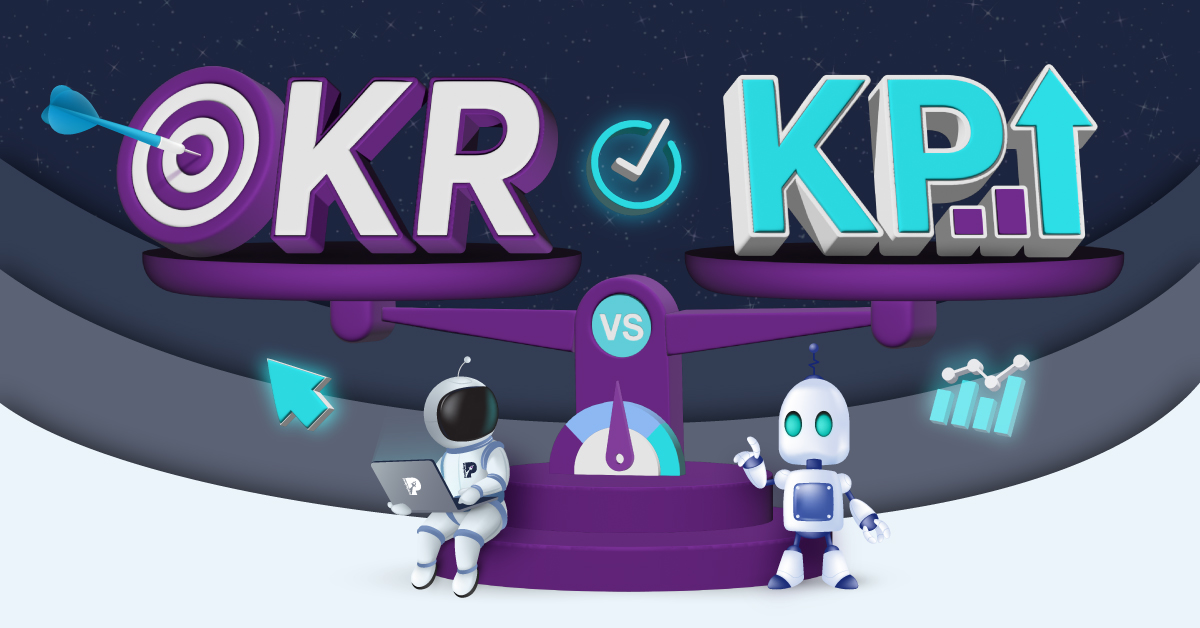
OKRs vs KPIs: Understanding the Differences and Synergies in Organisational Goal Setting
Key Takeaways
- OKRs and KPIs provide businesses with useful ways to track performance and strive for ambitious goals.
- While KPIs are indicators of performance, OKRs are the goals and plans for future performance.
- They can be used complementarily to achieve operational success, but this should be done cautiously since they can alienate staff members if done too rigidly.
Goal setting is an indispensable part of business strategy, forming the backbone of any business’s pursuit of success. Within this area, two terms frequently emerge at the forefront of strategic planning discussions: OKRs and KPIs. These acronyms represent powerful tools in a company’s arsenal, driving focus, alignment, and performance. But how do they differ? And how do they combine to create a strong goal-setting strategy?
While one sets ambitious targets to propel a company forward, the other tracks the tangible outcomes of business activities. This article will explain the differences between OKRs and KPIs, outlining how the two can be used together to enhance your business’s performance.
Let’s dive in.
OKRs (Objectives and Key Results)
What are OKRs?
Objectives and Key Results (OKRs) are a goal-setting framework used by organisations to define measurable goals and track their outcomes. In this context, an Objective is a qualitative and inspirational goal set on a quarterly or annual basis. For example:
- Grow company profits
- Give customers an excellent experience
Clearly, these goals are a bit vague and broad. However, that’s what the Key Results part is for. Key Results are specific, time-bound, and verifiable. They are the ways in which you can prove you have reached your Objective. For example:
- See a 10% increase in company profits in six months.
- Reduce manufacturing costs by 5% by swapping to a cheaper provider in the next twelve months.
- See a 20% increase in the number of positive customer experience scores in twelve months.
- Resolve customer service queries by 10% in six months.
Key Results must be realistic and relate directly to their corresponding Objectives. Usually, there are between three and five Key Results per Objective. They can be seen as a sort of ‘roadmap’ towards achieving your Objective. For example:
Objective:
- Boost company website’s SEO performance.
Key Results:
- Double monthly blog output from 4 to 8.
- Invest in a keyword research tool.
- Raise content quality by contracting an experienced writer.
- Gain 15 backlinks in the next six months.
Benefits of using OKRs
By having Objectives and Key Results laid out in this way, things are made super clear for everyone. It creates a process whereby CEOs and department leads must think about their goals deeply and come up with precise tactics to reach them. Plus:
- OKRs improve focus.
- Companies using OKRs are more transparent.
- Different parts of an organisation can be better aligned as they are working together towards a common goal.
- OKRs encourage regular check-ins to track progress.
- Everyone understands how their efforts contribute to the business, improving accountability and role satisfaction.
Once OKRs are in place, progress towards goals will be hugely enhanced by monitoring KPIs.
KPIs (Key Performance Indicators)
What are KPIs?
Key Performance Indicators (KPIs) are quantifiable measures used to evaluate the success of an organisation, employee, or a particular activity. Here are some examples:
- Return on investment (ROI)
- Conversion rate (CR)
- Bounce rate
- Average order value (AOV)
- Customer acquisition cost (CAC)
- Profit margin
- Net promotor score (NPS)
KPIs aren’t the goals themselves. They are the metrics used to measure whether a company has achieved its goals. While OKRs can be set quarterly or annually, KPIs are typically tracked continuously. They are crucial in assessing the health of an organisation and are used in tandem with OKRs.
Benefits of using KPIs
The benefits of using KPIs are several:
- KPIs help organisations measure their progress towards goals.
- KPIs keep staff members informed so that adjustments to strategies can be made promptly.
- KPIs easily communicate performance across a business.
- Employees are empowered by having clear performance targets.
- KPIs can enhance operational efficiency due to better decision-making and a deeper understanding of the factors that drive business success.
Despite being different things, OKRs and KPIs are often confused.
Comparing OKRs and KPIs
Once and for all, these two acronyms stand for very different things. While both OKRs and KPIs are used in the remit of goal-setting and goal-reaching, they serve different purposes and offer businesses different benefits. Here’s a comparison table to make things simple:
| OKRs | KPIs |
|---|---|
| OKRs are goal-setting frameworks that define desired outcomes and measurable steps to achieve them. | KPIs quantify the effectiveness of a business’s operations by giving exact measurements and figures. |
| OKRs stretch the capabilities of the team, usually being pretty ambitious figures for the future. | KPIs can change every day since they’re a real-time reflection of performance in the present moment. |
| OKRs are typically reviewed and updated on a quarterly basis, allowing for strategic shifts and adjustments in response to changes in business direction or market conditions. | KPIs tend to be monitored on a more continuous basis, reflecting the ongoing performance that supports the business’s day-to-day operations. |
| OKRs often inspire and challenge employees to strive for significant achievements that contribute to business growth. They are tied to strategic improvement and innovation within the company. | KPIs, while not goals themselves, are vital signs of operational health and serve as benchmarks for performance. They can instil a sense of responsibility and focus on maintaining the necessary standards of business processes. |
So, while OKRs drive the strategic agenda of a company and set a path for future success, KPIs provide the dashboard for the organisation, reflecting its current operational status. Understanding the relationship between these two acronyms enables companies to navigate efforts towards long-term goals while ensuring excellence in daily operations.
How OKRs and KPIs work together
The art of combining OKRs and KPIs lies in understanding how they can complement each other to drive success. When integrated, they can offer a robust framework for both aspirational planning and practical execution:
They work best when they’re aligned
If you decide to use both OKRs and KPIs, you should make sure they’re not in conflict with each other. OKRs and KPIs work best when they’re aligned. For example, there’s not much good in monitoring average order value if your OKRs relate to social media engagement.
The combination creates a useful feedback loop
When your business is using both OKRs and KPIs, it can develop a highly cohesive operation. Since KPIs offer real-time feedback on a company’s progress towards OKRs, businesses gain valuable insights into current efforts.
For example, the KPI of conversion rate on a mailing list sign-up form isn’t increasing, signalling that your efforts to optimise the form have not been successful. Equipped with this insight, your team can go ahead and investigate why their efforts failed and improve the form, working towards its OKR relating to customer acquisition and mailing list growth.
This feedback loop allows your business to remain focused on reaching its Objectives, as team members are made aware of progress in real time.
Using both helps you balance short and long-term goals
OKRs push a business towards future achievements, while KPIs ensure that the company’s current operations remain stable and effective. By aligning KPIs with the direction set by OKRs, a company can balance its immediate operational needs with its long-term strategic ambitions.
OKRs and KPIs help unite the entire company
When OKRs and KPIs are aligned, they encourage different parts of your organisation to work together towards common goals. For example, a KPI focused on customer satisfaction in the support department can directly impact an OKR in the sales department aiming to increase
customer retention. This refers to what is known as a ‘cascading strategy’ – popular for its cohesion of company departments.
Do’s and don’ts for KPIs and OKRs
So, we’ve gone through the ways in which KPIs and OKRs differ and how they can combine to create a united workforce, a focused strategy, and successful goal attainment. Now it’s time for our summarised list of do’s and don’ts to keep your use of OKRs and KPIs optimised:
Do:
✅ Create OKRs that are inspirational and stretch the organisation’s capabilities.
✅ Define Key Results that are specific, measurable, and directly tied to operational success.
✅ Align KPIs with OKRs to ensure they are working towards the same objectives.
✅ Ensure each team understands how their KPIs contribute to the business’s OKRs.
✅ Regularly review OKRs and KPIs, making adjustments as necessary.
✅ Use KPIs to inform the progress of OKRs and identify areas needing attention.
✅ Encourage open communication about goals across all levels of the organisation.
✅ Provide training and resources to help everyone understand how to use OKRs and KPIs.
Don’t:
❌ Create too many goals that can lead to confusion or a lack of focus.
❌ Set OKRs that are so complex they’re not easily understood or communicated.
❌ Forget that OKRs and KPIs should fit within the company’s culture and values.
❌ Use KPIs as a punitive measure, which can lead to a toxic work environment.
❌ Be rigid in OKR and KPI targets and not adapt to changing circumstances.
❌ Ignore feedback from the team on what’s working and what’s not.
❌ Focus solely on OKRs or KPIs at the expense of day-to-day operations.
❌ Set and forget either OKRs or KPIs; they should be living, breathing parts of your strategy.
By adhering to these do’s and don’ts, companies can effectively utilise OKRs and KPIs to drive strategic growth while maintaining strong operational health and a happy workforce.
Final thoughts
In practice, integrating OKRs and KPIs requires clear communication between teams, consistent monitoring of metrics, and a willingness to adjust as conditions change. When the power of OKRs and KPIs is harnessed effectively, it can make your business much more responsive, agile, and successful.
So, why not review your company’s goals and set up some OKRs?
While this guide has provided a foundational overview of the OKR and KPI basics, you can learn more by checking out our other articles on e‑commerce KPIs and email marketing KPIs. Plus, why not subscribe to our email newsletter for weekly articles about digital marketing, business management, and more?
